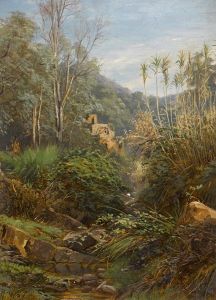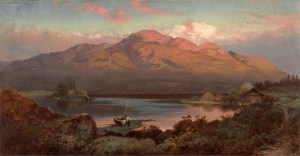At a historical inflection point during the American Civil War, it was uncertain what Canada would become… would we become an independent republic, or a part of Lincoln’s America or would we remain a Northern anti-American confederacy under British control? (Britain’s other confederacy did fail in 1865 after all).

Nowhere was this battle over our identity expressed more clearly than in our national arts. It is here that one Robert Duncanson (1821-1871) enters the stage. Living in Montreal during the height of the Civil War from 1863-1865, Duncanson had already become world renowned as the leading figure of the Hudson River School and greatest African American painter in his time. Born of a Scottish father and African american mother, Duncanson was recruited to the Hudson River school by William Sonntag in the 1850’s in Cincinnati where they shared adjacent studios. He quickly took up his role in the combat against the institution of slavery with the brush and poetry working closely with abolitionist networks throughout America, donating many of his works for the cause of freedom and polemicizing against slavery through his poetic subject matter, as evidenced in his Land of the Lotus Eaters which featured a multi-layered attack upon the oligarchical worldview unveiled in Pierre Beaudry’s essay “Robert Duncanson and the Paradisiacal Paradox“.
While in Canada, Duncanson literally shaped an incredibly influential network of painters such as Charles Way, John Fraser, Allan Edson and Otto Jacobi among others, who resonated powerfully to the Hudson River school method of communicating the Divine in both man and nature. His philosophy was expressed in his own words when he said: “Mark what I say here in black and white. I have no color in the brain- all I have on the brain is paint… I care not for color: Love is my principle, order is the basis, progress is the end”.
Defining his understanding of the highest purpose of art, Duncanson hung a note on his studio door stating “The mere imitation of the form and colors of nature is not art, however perfect the resemblance. True art is the development of the sentiments and principles of the human soul – natural objects being the medium of illustration.”
It took many years of cultural warfare for the British imperialists to corrupt Canadian art, derailing its Promethean evolution towards a slow, deconstructing school of modernism- all of which was made possible by the spread of the luminist/romantic movement during the end of the 19th century. This 19th century infusion of sensualism then paved the way for the rise of the “Emily Carr and the Group of 7” as a new unassailable standard bearer of mystical nature worship during the early of the 20th century. Contrary to popular belief, this turning away from the Hudson River School tradition was never an organic evolution of Canadian aesthetics but rather a conscious suffocation of a Promethean fire that was emerging within the soul of a people who were destined to be more than the British Monarchy had in mind.
If a principled school of painting can arise in Canada once again, re-discovering this forgotten tradition will be vital… I have in this spirit, here featured a small array of Duncanson’s paintings as well as those of his direct students and other forgotten painters in Canada who were influenced by the Hudson River School as well as the Thomas Eakins school at the end of the 19th century. Many of their most powerful paintings, and those of Duncan’s, it must be noted were systematically buried by the oligarchy whose simple technique in those days before digital reproductions, was to purchase republican-spirited works en masse, and then bury them from public viewing indefinitely. It is for this reason that a figure as important as Robert Duncanson, and his co-thinkers could remain forgotten for so long.
Enjoy some beautiful paintings and be sure to check out Pierre Beaudry’s pioneering work on the Hudson River School in his book following this link.
Robert Scott Duncanson








Allan Edson
Allan Edson (1846-1888) was a pupil of African American Hudson River School painter Robert Duncanson. He was a co-founder of both the Montreal-based Society of Canadian Artists in 1867 and the Ontario Society of Artists in 1872. Much of the spirit of the Hudson River School flows vibrantly through his landscapes. In the 1880s, he fell under the influence of Barbizon painter Leon Pelouse in France and consequently lost his capaciites for conveying the divine behind the forms he chose as subjects of paintings.







C.J. Way
Charles Jones Way (1834-1919) was another Canadian student of African American painter Robert Duncanson, travelling with Duncanson (as well as Allan Edson) to Europe after the Civil War. After meeting the Hudson River painter in 1863 C.J Way was inspired to break from his British aesthetic conditioning, focusing increasingly on the spirit of the sublime underlying the senses rather than the effects of the senses themselves. He was the founder of the Art Association of Montreal in 1860, and founder/President of the Society of Canadian Artists in 1867. After 25 years in Europe, C.J Way returned to Canada on the invitation of William van Horne (President of the Canadian Pacific Rail) in 1898 to travel and paint the Canadian frontiers on the Trans continental rail. While this series is praised as the most dramatic and inspired landscapes of Canada, they have nearly all been lost from public view, having been systematically purchased by private collectors and buried from public view. Due to the aborted development of Canada as a Promethean nation after the 1867 BNA act was passed to block the spread of Americanism on the Continent, Way’s maturation as a promethean artist seems also to have derailed quite a bit.










Lucius O’Brien
Lucius O’Brien (1832-1899) was a vice president of the Ontario Society of artists and was renowned for his watercolour and oil paintings of the frontier. O’Brien’s connection to the Hudson River school came not through Duncanson, but rather through his association with Albert Bierstadt who he befriended in the 1870s. His talents for capturing the grandeur of Canada’s landscapes was put to great work during his several tours on the Canadian Pacific Railway on the invitation of CPR President William van Horne. Like many of his talented contemporaries, O’Brien’s later works became infested with luminism movement and romanticism losing its pioneering potency.










Otto Reinhold Jacobi
Otto Reinhold Jacobi (1812-1901) was a German-Canadian painter who lived in Canada from 1860-1870 and was highly influenced by Robert Duncanson during the later’s 1863-1865 sojourn in Montreal. Although later falling deeply into the Luminist school alongside many other great painters such as Lucius O’Brien, Jacobi’s work while under the influence of the Hudson River school spirit remains some of the greatest gems of Canadian painting.









John Arthur Fraser
John Arthur Fraser (1838-1898) was among those highly influenced by Duncanson in Canada. Fraser was extremely active in forming a school of Canadian arts, co-founding the Art Association of Montreal, the Ontario Society of Artists and Royal Canadian Academy of Arts. In 1869, he joined the first salon of the American society of watercolor Painters in New York.










Homer Watson
Homer Watson (1855-1936) stands as one of the most influential landscape artists of Canada. Having almost no formal training, Watson blossomed through his exposure to the Hudson River school painting tradition while he studied art in New York for two years. It was there that he met Hudson River painter George Innes which shaped his early years. By the mid-1870s, he also befriended Lucius O’Brien who assisted his career greatly. The last 40 years of Watson’s life featured a deconstructive leap into impressionism.












Robert Reginald Whale
Robert Reginald Whale (1805-1887) moved to the frontiers of western Ontario in 1852 and focused on developing his skills in landscaping and portraiture. His work popularized rail development and inspired the view of the frontier. Although his official biographies only mention the British school influences of John Constable and Sir Joshua Reynolds, one would not be surprised to discover Hudson River inspiration through a bit of research. Both of his sons (Robert Jr, and Jean Claude) also became accomplished artists in their own right.









The Thomas Eakins Influence in Canada
Another potent current in Canadian painting during this period is also worth showcasing. Though less Promethean than its Hudson River School counterpart, is the Thomas Eakins school of Philadelphia which influenced a network of Canadian artists who strove to communicate narratives, insights and anecdotes moral and quaint which all transcended the literal imagery on the canvas, presaging the sort of spirit exhibited later by American painter Norman Rockwell.
Paul Peel
Paul Peel (1860-1893) was one of several Canadian students of Thomas Eakins who produced an enormous body of work during his short time, and played a major role in shaping Canadian Aesthetics. He was being the first Canadian painters to earn international recognition during his lifetime.












George Reid
Another Canadian painter George Agnew Reid (1860-1947) was also a pupil of the great Thomas Eakins of Philidelphia. Reid’s work demonstrates not only his technical powers but also his abilities as a story teller.








Robert Harris
Robert Harris (1849-1919) was an accomplished violinist and flutist who decided in the 1860s to focus his talents on fine arts. During his two year stay in Boston studying fine arts, Harris became influenced by American techniques with a focus on the Eakins school. Later, under the guidance of Lucius O’Brien, he became a founding member of the Canadian Academy of the Arts. His incredible skills at portraiture brought him into very high level contact with the British oligarchy’s Canadian handlers, and to this extent he is perhaps best known for his depiction of the “Fathers of Confederation” which burned with Canada’s parliament building in 1916.








Very interesting selection of pre-1900 Canadian Visual Artists that I had only a rough acquaintance with. I also enjoyed mention of influence of Constable/Reynolds as many years ago I attended an exhibit curated by AGO entitled “Constable and the Sublime” and those images certainly evoked the same response as this selection.
Finally I did not know about the Thomas Eakins School and Norman Rockwell connection so thank-you for noting. Again years ago an old Toronto pal who had distant relatives in Philadelphia that may have been Eakins – and I was very grateful too as they directed me to the Barnes Foundation Collection back in 1988 when it was still in its majestic old home in an old neighbourhood that was faintly reminiscent of film “The Philadelphia Story”.
However (despite enjoying the pun) I fail to see how these painters were “derailed”. What I do sense is that this was a talented group of Canadian artists that have been neglected within our education establishment.
At University I dated an Art History major and according to most of what I learn from her “Art in Canada” barely began until the Group of Seven” in the 1920’s and 1930’s once the Canadian Council began to fund purchases. We were still together when she got a job as Receptionist/Girl Friday at well-known art dealer Av Issacs near Bloor & Younge St in Toronto and I recall meeting most of those drunken artists like Wieland, Snow, Meredith, Coughtry, Markle, Rayner and among the most memorable Saskatchewan’s William Kurlek.
When I was a boy our Canadian History books were filled with vivid wood cuts prints portraying events designed by C.W Jeffrerys. I miss those books terribly.
https://www.thecanadianencyclopedia.ca/en/article/canadian-painting-in-the-19th-century
https://www.thecanadianencyclopedia.ca/en/article/painting-modern-movements
https://www.thecanadianencyclopedia.ca/en/article/drawing